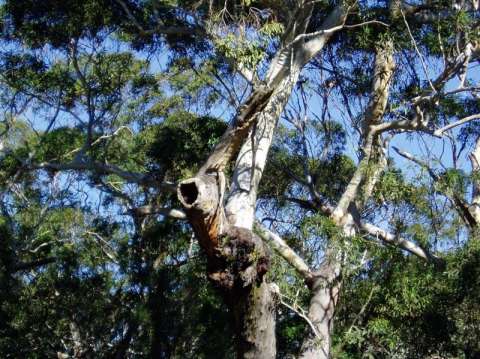This is an opportunity for local covers to contribute to a project that identifies wildlife living in hollows.
In urban and agricultural areas large, hollow-bearing trees are in decline, but many species of animal rely on tree hollows. In NSW, hollow-dependent species include at least 46 mammals, 81 birds, 31 reptiles and 16 frogs. Of these, 40 species are listed as threatened with extinction. This is why the ‘loss of hollow-bearing trees’ has been listed as a key threatening process to biodiversity in New South Wales.
Farms and agricultural areas are often characterised by large, old, isolated tree, or small clusters of trees. These clusters of trees often act as ‘stepping stones’ and can be vital in linking up other small patches of trees on adjacent farms and allowing wildlife to more easily move throughout the landscape (for example, a glider gliding between patches of trees). Even a single standing tree with a hollow can provide valuable habitat and provide a nest or den for an animal that would otherwise not be able to live on that farm. A good example of an animal that depends on clusters of trees on farms is the Superb Parrot, listed as vulnerable to extinction, which uses paddock trees for nesting, feeding, landing and protection. Retaining existing hollow-bearing paddock trees, along with ensuring that younger paddock trees are maintained so that they form hollows, and gaining a greater understanding of how wildlife use paddock trees is vital to maintaining wildlife in our agricultural areas.
It’s not just on our farms that hollow-bearing trees play an important role, but within our urban regions as well. Hollow-bearing trees are often removed in cities, their suburbs and smaller towns for development. Alternatively, large trees may be retained (such as in recreational parks or streets), but dead or damaged branches may be removed for reasons of public safety (in case they fall). The removal of these damaged limbs prevents a hollow forming in the tree. There are also fewer young trees in the city, compared to the bush, which can grow up into large hollow-providing trees. The combination of these three factors means there a fewer trees in metropolitan areas compared to the bush, and therefore fewer hollows for wildlife. Urban bushland typically contains only half the number of hollows that are present in in bushland outside metropolitan areas and there are even fewer hollows in parks and streets. Additionally, not all hollows are the same, and some species prefer particular types of hollows (for example a deep hollow, a hollow with a small entrance or a ‘pipe’ style hollow. When we lose the hollow-bearing trees, we also reduce the number of different types of hollows, which can result in fierce competition between wildlife, with some species losing out to more dominant species, for example the rainbow lorikeet taking a hollow from the eastern rosella. It has been shown that there are more aggressive interactions at hollows in urban areas than what there are in natural bushland outside of urban areas.
Hollows as Homes aims to increase the knowledge and understanding that we have about tree hollows; the distribution of tree hollows, the types of hollows available and how wildlife use tree hollows, including artificial hollows or nest boxes. Artificial hollows and nest boxes are often used as a replacement for, or alternative to, natural tree hollows. However, the effectiveness of these alternatives is still not entirely understood. Participants in Hollows as Homes will be providing valuable information on the number and distribution of hollows, distribution of different types of hollows and wildlife that is using the hollows and nest boxes. Some of this information is still largely unknown, for example the number of hollow-bearing trees that exist in people’s backyards and wildlife use trees in backyards. The information that Hollows as Homes collects will be used to add to the scientific literature, to allow councils to better plan our suburbs and retain existing habitat that is important for wildlife and to educate the community about the importance of tree hollows, as well as understand exactly what is using our own backyard!
For information on how you can be a part of this exciting project, visit www.hollowsashomes.com or facebook.com/hollowashomes. Alternatively, you can email Dr Adrian Davis at hollows.ashomes@gmail.com. For more information.
Hollows as Homes is a collaborative project between the University of Sydney, The Royal Botanic Garden and the Australian Museum.
It is supported by the Sydney Coastal Councils Group through funding from the Australian Government



